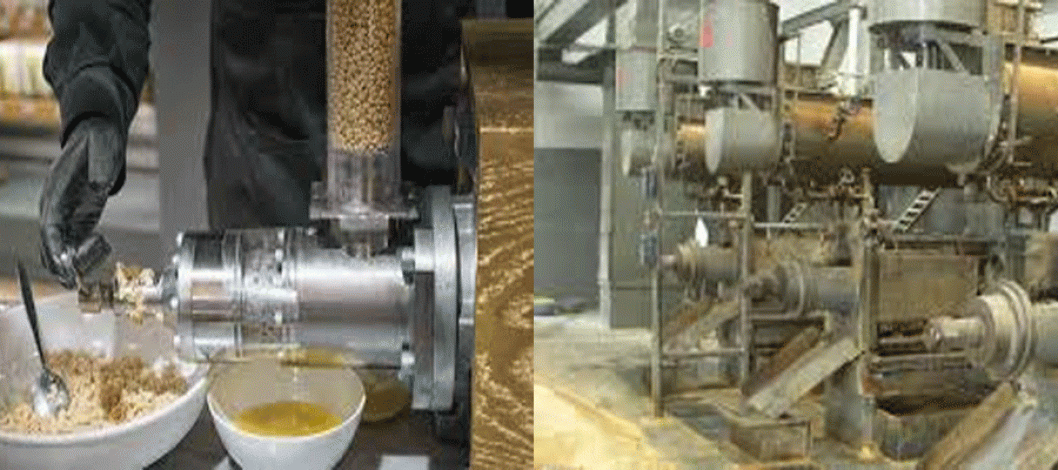
File Photo
A number of small‐ and medium‐sized facilities produce native, cold-pressed rapeseed oil by using only screw pressing and purification of the oil by filtration or sedimentation. This procedure is not new, and the extraction of oilseeds by small presses, going back several hundred years, is rediscovered by the farmers as one possibility to produce products with added value instead of delivery of the seeds after harvest to the large oil mills. The extraction of rapeseed is remarkably less
Extraction by Solvent
Extraction by solvent is recommended if it is necessary to reduce the oil content in the raw material to lower than 2%. That means the aim of extraction by solvent is to remove as much oil as possible from the oilseed. From an economic point of view, pre-extraction by screw presses is advisable because equipment and maintenance for solvent extraction are very costly. In most cases, hexane is used as a solvent because it is cheap, has good oil solubility at relatively low temperatures, has an
Enzyme Pretreatment
An interesting method to enhance the oil recovery from the seeds is their treatment by enzymes. The aim of this procedure is to modify the seed coat and cell walls to increase the oil yield; as a result, the disruption of cell walls by mechanical treatment during flaking is reduced. The extraction time decreases, which increases the efficiency of the pressing process by up to 92%. This procedure demands a lower energy requirement and results in less losses of hexane during solvent extraction.
Separation of Solvent and Oil
After the solvent extraction process, the resulting miscella contains 20–30% oil in hexane. For an economical procedure, the recovery and reutilization of the solvent is necessary. Since recovery of solvent needs energy and equipment, the aim must be to obtain as much oil as possible from the miscella with an economically justifiable need for energy.
After leaving the solvent extractor, the finest particles of the seed material resulting from the treatment during solvent extraction, especially
Toasting of the Meal
For the further commercialization of rapeseed meal, it is necessary to remove all hexane from the solvent-extracted cake in order to observe the limits of the feeding stuff regulations and to avoid the danger of explosions. After the extraction process, about 25–35% solvent remains in the cake, which has to be removed by evaporation in a desolventizer‐toaster. Another effect of this procedure is the drying and crisping of the meal and the recovery of the solvent for further use.
Older equipment
Other Extraction Methods
One alternative to common methods used is the extraction of rapeseed by carbon dioxide under supercritical conditions. Under these conditions (temperature >31.1 °C and pressure >73 atm) carbon dioxide adopts properties midway between a gas and a liquid, with comparable dissolving power as hexane. Carbon dioxide has the advantage of not being toxic, easy to remove from the oil, and being nonflammable. Thus, the method is very gentle to minimize the deterioration of the product during extraction, and
Purification of the Crude Oil
Additionally, to ninety‐eight percent triacylglycerols, crude oil contains phospholipids, free fatty acids, colored pigments, sterols, waxes, oxidation products, moisture, aroma components as well as plant parts, and dirt in varying amounts depending on the conditions of the extraction process. The more extensive the extraction conditions, the higher the amount of minor compounds, which strongly impair the quality and the shelf life of the oil. Refining involves different steps because otherwise the
Cold Pressed Oils
Purification of native, cold-pressed rapeseed oil means separation of solid impurities, mainly particles of the seeds. This is an important step to ensure the quality of the oil for long storage. Disrupted particles of the seeds contain enzymes and also adherently microorganisms that can metabolize the oil to form degradation and metabolism products impairing especially the sensory quality of the oil. Depending on the settings of the screw press, speed of the rotating screw shaft, size of the
Degumming
Oils contain high amounts of phospholipids, which should be eliminated because they are jointly responsible for deterioration of the quality during storage. Autoxidation reactions during storage and processing lead to the formation of dark‐colored substances from phospholipids and these substances are called melanophosphatides.
The content of phospholipids varies from 1 to 1.5% in the crude oil, corresponding to 400 and 600 mg/kg calculated as phosphorous. Two forms of phospholipids exist, See more.
Source: Online/OFA
Comment Now